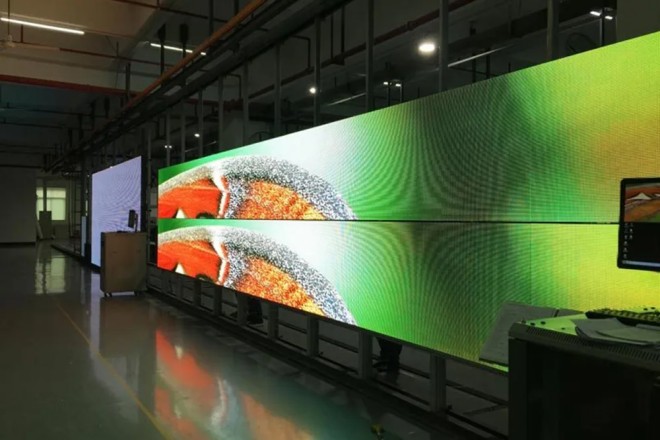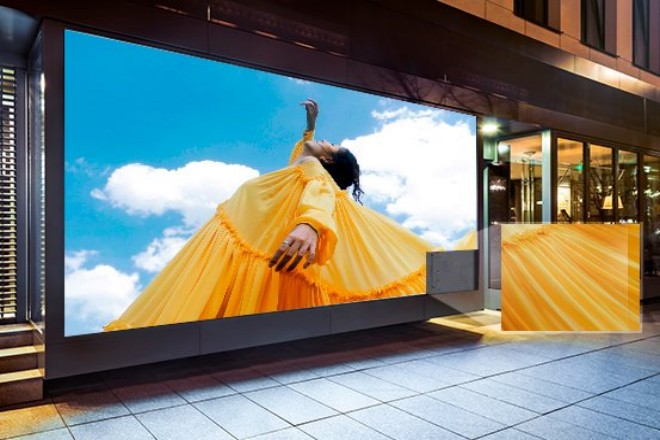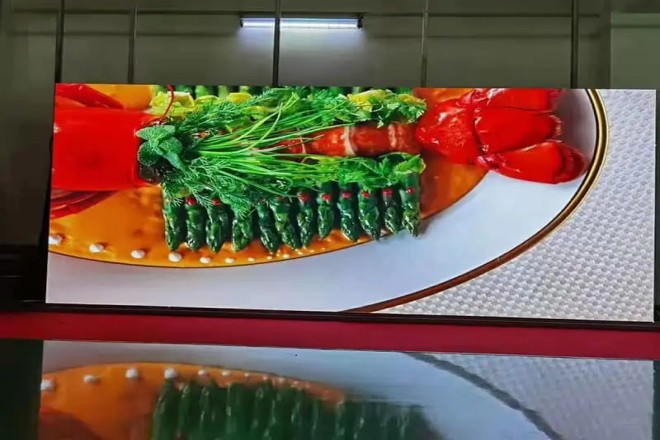소개

발광 다이오드 표시 스크린, with their excellent display effects and flexible splicing capabilities, have become the shining star of modern display technology. However, the problem of splicing gaps is like a flaw in beautiful jade, affecting the visual coherence and overall aesthetics.
This article aims to analyze the causes of LED display splicing gaps deeply and explore effective solutions in order to promote the further development and improvement of LED display technology.
1. What impact does the gap in the LED display have on the display effect?

The impact of gaps in LED display screens on display effects is a complex and multi-dimensional issue. It is not only related to technical accuracy but also directly related to the audience’s visual perception and overall experience.
1). Disruption in visual continuity
The existence of gaps in the LED display will significantly affect the visual continuity of the picture.
When you stand in front of a large screen made up of multiple small pieces, if the gaps between these small pieces are clearly visible, your line of sight will be inadvertently interrupted by these gaps, and you will not be able to form an understanding of the picture.
This visual incoherence not only reduces the appeal of the image but may also confuse and discomfort the viewer. Especially when watching dynamic pictures or complex scenes, the existence of gaps will make the entire picture appear fragmented, making it difficult to present the smoothness and vividness it should have.
2). Limited viewing angles
The gap will also impose certain restrictions on viewing angles. Since the gap may present different visual effects at different angles, viewers may find that the gap is particularly obvious when viewing from certain positions, thus affecting their viewing experience.
This limitation is particularly evident in large-scale events or exhibitions, as audiences tend to come from all directions and have different viewing angles. If the gap in the display is not managed properly, some viewers may be disappointed because they cannot get the best viewing angle.
- Picture distortion and color deviation
In addition, gaps may cause picture distortion and color deviation. Because each small piece of screen may have subtle differences in brightness, color saturation, etc., when they are stitched together, these differences will create obvious contrasts in the gaps.
Not only does this contrast make the image look unnatural, but it may also make the viewer doubt the authenticity of the content being displayed. Especially in situations where accurate color and detail are required, such as art exhibitions or scientific demonstrations, the presence of gaps can be a downfall to the entire display.
3). Negative impact on overall aesthetics and professional image
Gaps will also have a negative impact on the overall aesthetics and professional image of the LED display. A well-designed display should be able to grab the audience’s attention and deliver a professional, high-end message.
However, this professional image is compromised if the display is filled with noticeable gaps. Viewers may think that the quality of the display is not up to par, creating a sense of distrust in the content being displayed.
At business events or conferences, this sense of distrust can further impact a brand’s image and reputation.
2. What are the causes of gaps in LED display splicing?
1). Design and manufacturing details
- Unit board size tolerance:
When each LED unit board is like a small puzzle piece, its size must be very precise to fit together perfectly. However, in actual production, due to process and equipment limitations, there may be slight differences in size between unit boards, such as 0.1 mm or less. When these unit boards are spliced together, these tiny differences add up to create the gaps we see.
- Frame width and connectors:
The frame width of the LED module is also a key factor affecting the gap size. If the frame is too wide, the gaps formed during splicing will be more obvious.
In addition, the accuracy of connecting parts (such as brackets, screws, etc.) and errors during installation will also affect the size of the gap. For example, if the tolerance of the connector exceeds 0.05 mm or if it is not accurately aligned during installation, it may cause gaps.
2). Materials and environmental factors
- Thermal expansion and contraction:
Different materials behave differently when thermal expansion and contraction occur. The manufacturing materials of LED displays, such as panels and frames, will produce small dimensional changes when the temperature changes.
If the thermal expansion and contraction coefficients of different materials are very different, for example, when the temperature changes by 10 degrees Celsius, one material expands by 0.2 mm, while the other material only expands by 0.1 mm, then gaps may occur at the splicing point.
- Long-term use and wear:
During long-term use, each component of the LED display will experience a certain degree of wear and deformation. For example, the connectors may become loose or worn, causing the screen to become misaligned; the panel may change size due to aging or deformation. These changes may affect the splicing effect of the screen, thereby creating gaps.
3). Stitching technology and calibration
- Splicing methods:
Seamless splicing and conventional splicing are two common splicing methods. Seamless splicing technology can minimize the size of gaps through special processes and algorithms and even achieve an almost seamless display effect.
However, the cost and technical requirements of this technology are also relatively high. In contrast, conventional splicing methods may leave larger gaps.
- Calibration accuracy:
The calibration accuracy during splicing has a crucial impact on the size of the gap. If the calibration is not accurate, the spliced screens will have problems such as misalignment and unevenness, resulting in gaps.
Therefore, during the splicing process, high-precision calibration equipment and algorithms need to be used to ensure that each unit board can be spliced together accurately. Typically, calibration accuracy needs to be 0.01 mm or higher.
- Software and algorithm support:
Advanced stitching software and algorithms can provide more accurate calibration and stitching effects. Through complex calculations and optimization, these software and algorithms can minimize the size of the gap and improve the display effect of the screen.
For example, some advanced splicing software can automatically identify and adjust the small differences between unit boards to ensure that the spliced screen is smooth and seamless.
4). Design and Planning
- Early design:
If the splicing requirements are not fully considered in the early design stage, various problems may occur during actual splicing. For example, parameters such as screen size, resolution, and frame width may not be reasonably designed according to splicing requirements, resulting in gaps or unevenness in the spliced screen.
Therefore, it is necessary to fully consider the splicing requirements during the design stage and formulate corresponding design plans.
- Matching screen size and resolution:
The degree of matching between screen size and resolution is also an important factor affecting the size of the gap.
If the screen size is too large or the resolution is too high, and the splicing solution cannot fully meet these requirements, the spliced screen may have problems such as misalignment, unevenness, or gaps.
Therefore, when selecting screen size and resolution, it is necessary to fully consider the matching relationship between them and formulate a corresponding splicing plan.
3. How to reduce or eliminate the problem of gaps in LED displays

When discussing how to effectively reduce or even eliminate the gap in LED display screens, we have to analyze it in depth from multiple angles and propose a series of practical and innovative solutions. Below, we will unveil the mysteries of these methods one by one.
1). Technological innovation and process improvement
- Breakthrough in ultra-narrow bezels and seamless splicing technology
Did you know? Nowadays, the borders of LED display screens can be very narrow; some are even less than 1 mm!
This ultra-narrow bezel design, coupled with sophisticated, seamless splicing technology, allows the gaps to be almost invisible when multiple display units are spliced together. There are already many such products on the market that achieve a near-perfect visual experience through superb manufacturing processes.
- The powerful combination of high-precision machining and intelligent calibration
Laser cutting and CNC precision machining technology are used in the manufacturing of LED displays. How high is the accuracy?
The size of each unit board can be accurate to the micron level, and the error during splicing is almost zero. Coupled with the help of the intelligent calibration system, high-precision sensors, and algorithms can monitor and automatically adjust minute differences between unit boards in real-time to ensure that the spliced screen is as smooth as a mirror.
- Upgrading the modular design
The modular design not only makes the installation, disassembly, and maintenance of LED displays more convenient but also greatly reduces the gaps caused by improper connections between unit boards. Today’s modular designs are more flexible and diverse and can be customized and adjusted according to different needs.
2). Material selection and performance improvement
- The secret of thermal expansion coefficient matching
When selecting display materials and connectors, we have to consider whether their thermal expansion coefficients are similar.
If the difference is too large, gaps will appear when the temperature changes. Therefore, it is particularly important to choose materials with excellent thermal stability, such as special plastics or metal alloys that are resistant to high and low temperatures.
- Reinforcement and stability of panel structure
In order to enhance the stability of the panel, we use stronger and more durable materials, such as high-strength aluminum alloy or carbon fiber composite materials. At the same time, the panel has also been reinforced, such as increasing the thickness of the frame and using reinforcing ribs, to make the panel more resistant to deformation.
3). Enhancement of environmentally adaptable design
- The wisdom of temperature and humidity control
The temperature and humidity of the display installation environment have an important impact on the display effect. Therefore, we set up temperature and humidity control systems to keep the environment stable.
Especially in outdoor displays, we also install facilities such as awnings and ventilation systems to reduce the negative impact of temperature changes on the displays.
- Clever choice of connectors
The choice of connectors is also crucial. We selected connectors that can adapt to different environmental conditions, such as connectors with elastic compensation functions. In this way, even if environmental changes cause gaps to occur, they can be compensated and adjusted through the elasticity of the connector.
4). Guarantee of professional installation and subsequent maintenance
- Precise construction by a professional team
Have an experienced professional installation team. They will use professional tools and techniques to install the display to ensure that each unit board can be spliced together accurately. In this way, the splicing gaps are greatly reduced.
- Adhere to regular maintenance inspections.
Regular maintenance inspections of the display are essential. We check for things like cleanliness, screw tightness, and the condition of connections. Once a splicing gap problem is discovered, we will immediately adjust and deal with it. At the same time, we will also establish maintenance files to record the status and results of each maintenance for subsequent analysis and improvement.
결론
Looking to the future, with continuous innovation and technology optimization, the problem of LED display splicing gaps will be more effectively solved. We expect that future LED displays will achieve truly seamless splicing, bringing a more shocking and realistic visual experience to the audience.
Finally, if you want to know more information about LED displays, please contact us.
